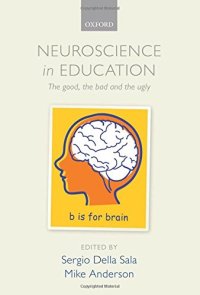
Ebook: Neuroscience in Education: The good, the bad, and the ugly
Author: Sergio Della Sala Mike Anderson
- Tags: Education & Reference, CPA Test, GMAT Test, Statistics, Business & Money, Behavioral Sciences, Anthropology, Behavioral Psychology, Cognitive Psychology, Science & Math, Neuroscience, Neurology, Internal Medicine, Medicine, Economics, Economic Theory, Macroeconomics, Microeconomics, Business & Finance, New Used & Rental Textbooks, Specialty Boutique, Neuroscience, Basic Sciences, Medicine, Medicine & Health Sciences, New Used & Rental Textbooks, Specialty Boutique
- Year: 2012
- Publisher: Oxford University Press
- Edition: 1
- Language: English
- pdf
In the past ten years, there has been growing interest in applying our knowledge of the human brain to the field of education - including reading, learning, language, and mathematics. This has resulted in the development of a number of new practices in education - some good, some bad, and some just crazy. Hence we have had theories suggesting that listening to Mozart can boost intelligence, foot massages can help unruly pupils, fish oil can boost brain power, even the idea that breathing through your left nostril can enhance creativity! Sadly, there is a gap between what neuroscientists or cognitive psychologists know about brain/mind functions and the supposedly scientific theory underlying the practices used daily in our schools. So what has caused this wholescale embrace of neuroscience in the classroom- a well-intentioned, but naive misunderstanding of how science works, ideological reasons, or financial incentives?
Neuroscience in Education brings together an international group of leading psychologists, neuroscientists, and geneticists to critically review some of these new developments, examining the science behind these practices, the validity of the theories on which they are based, and whether they work. It will be fascinating reading for anyone involved in education, including psychologists, teachers, and policy makers.
Neuroscience in Education brings together an international group of leading psychologists, neuroscientists, and geneticists to critically review some of these new developments, examining the science behind these practices, the validity of the theories on which they are based, and whether they work. It will be fascinating reading for anyone involved in education, including psychologists, teachers, and policy makers.
Download the book Neuroscience in Education: The good, the bad, and the ugly for free or read online
Continue reading on any device:

Last viewed books
Related books
{related-news}
Comments (0)